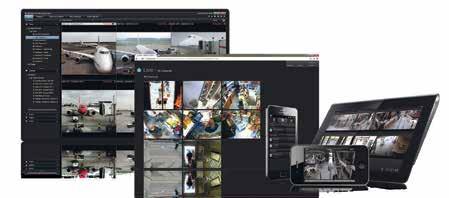
21 minute read
EVIDENCE-BASED LP
Opinion vs. Fact
by Read Hayes, Ph.D., CPP
Dr. Hayes is director of the Loss Prevention Research Council and coordinator of the Loss Prevention Research Team at the University of Florida. He can be reached at 321-303-6193 or via email at rhayes@lpresearch.org. © 2013 Loss Prevention Research Council
As the old saying goes—“We are all entitled to our own opinions, but not to our own facts.” This column emphasizes how the best path to improving the impact of loss prevention or asset protection programs is by developing enough research findings to support real, evidence-based practice. LP practitioners require good operational how-to concepts plus cross-sectional and experimental research evidence to better diagnose and treat the myriad of dangerous and costly problems retailers face daily.
Best Practice vs. Evidence-based Practice
I took the following example from an evidence-based medical publication (Yokl, 2010) to illustrate the difference between anecdotal and evidence-based practice:
“Do you see the difference? Anecdotal or loosely based evidence, even if reported by hundreds of practitioners, doesn’t make a best practice legitimate. Do you remember when it was believed that almost all stomach (or peptic) ulcers were thought to be caused by stress? Now, we know with certainty, based on rigorous evidence-based research in 1982 by two Australian scientists that 70% to 90% of peptic ulcers are caused by bacteria.
“It’s interesting to note that John Lykowkis, a general practitioner in Greece, believed peptic ulcers were caused by bacteria in 1958, and then treated his patients with antibiotics, which is now an evidence-based best practice. But he never did the rigorous evidence-based research to prove it. Unfortunately, he left the rest of his colleagues to figure it out for themselves.”
Believe it or not, for decades most physicians refused to believe clean hands prevented infection. It wasn’t until randomized controlled trials were published in the late 20th century that doctors started washing their hands before surgery.
And so it is in our discipline. Many retailers and solution partners are doing small tests, but many of these tests are not rigorously designed or executed, and most are never peer-reviewed and reported. But because of the incredible efforts of over thirty-five retailers driving the LPRC now, and many others, we’ll get there.
What Happens Over Time?
One concept our LPRC and University of Florida research teams take into account in innovation and evaluation projects is that of the role of time and behavior. Time is so critical in crime and loss control. It takes time for crime prevention measures to take effect (reach therapeutic level) since offenders need to personally or otherwise learn of their presence and mechanisms of action. And if the protective measures are perceived effective, the word has to spread out there. So, we have to be patient, and we need long-term studies to better calculate these timelines and their causes.
Time also reveals how criminals react to our countermeasures. We’ve discussed the concept of crime displacement. Prevention treatments can convince offenders to alter their target, timing, location, and methods rather than just desist. Many studies show this type of crime movement is common, but not always as common as the opposite effect called diffusion of benefits, or the halo effect where offenders mistakenly believe other items and places are similarly protected when they really aren’t.
A longer term effect of crime and loss control efforts may also lead to adaptation where offenders learn of protective measure design or execution flaws and adapt their behavior accordingly. We can all pick our favorite LP measure that is no longer as effective as it used to be since cynical bad guys found out or heard the thing doesn’t work, is a bluff, or employees don’t enforce it. There is more to come later on our research that is taking the effects of time on LP programs.
Impact 2012 Conference Highly Rated
It’s really tough to improve on certain things. Our annual Impact conference is far from perfect, but this past year’s
conference…our eighth…was rated better than ever by the over 120 executive participants. Here’s some of what we did and learned at the 2012 Impact conference.
John Voytilla, vice president of global LP and CSO of OfficeMax, facilitated a wide-ranging panel discussion on using innovation to address upcoming issues and challenges. The panel participants were Brand Elverston from Walmart, Dr. Richard Hollinger and Dr. Steve Kirn of the University of Florida, and Ned McCauley from Tyco Integrated Security. The panel looked at building LP staffs with the needed skills to handle the diversity and complexity of the expanding asset protection role, as well as technology needs and how to get there.
Several of our working group leaders briefed the attendees on what has happened and is planned in the future. After the briefings, attendees separated into individual meetings of the working groups to brainstorm 2013 objectives and processes. The briefings and breakout meetings were headed by the following individuals: ■ Packaging Innovation Working Group—Shannon Hunter,
OfficeMax; ■ Benefit-Denial Working Group—Tim Fisher, Best Buy; ■ Predictive Analytics Working Group—Carlos Bacelis, Sears
Holdings; and ■ Video Analytics Working Group—Ahmad Lightfoot, T.J.Maxx.
Walmart’s Dain Sutherland outlined how LPRC uses the “SARA” problem-solving model followed by a short exercise. The SARA model was discussed in depth in this column in the November-December 2012 issue (page 50).
A major focus of this year’s Impact conference was the presentations and breakout groups on the so-called “digital journey” led by Don Burkett of Sears Holdings and Ed Weiser of Motorola, and mobile POS let by Katie Freiday from The Home Depot.
A number of roundtable discussions on research ideas on a variety of subject areas, including data analytics, video analytics, alarm management, RFID, merchandise protection, loyalty programs, online fraud, safety and environmental integration, and LP hiring practices.
Several recent LPRC research results were discussed including: ■ Predictive analytics—Overall shrinkage and key shrinkage factors, shrink symptoms, parking lot crime, and burglary. ■ Manager confidence open-access study. ■ StoreLab—People counting, infant formula protection, and spirits protection.
Danny Sorrells from Walmart also facilitated roundtable discussions on best practices surrounding talent recruitment and development, as well as on what customers are saying about asset protection.
Finally, the participants interviewed active amateur and professional theft offenders on stage and in a StoreLab mock-up in the University of Florida ballroom facility.
This year’s Impact conference was a great success due to the incredible content and logistics planning led by Shannon Hunter and the LPRC’s Corrie Tallman, as well as so many others who contributed and participated. We look forward to implementing the research activities the group identified in Gainesville. If you did not attend the 2012 conference, please consider not missing the 2013 event in October. Watch for the exact dates to be announced soon.
Maximize Cash Flow
ACCEPT BILLS AND DISPENSE COIN WITH CONFIDENCE AND VISIBILITY
• Increase visibility and “anytime reporting”– remote access management and immediate view of cash flow, with detail reports for accountability audits • Employee self-service – increase cash management productivity with direct, authenticated and traceable employee deposits • Remote management – remote access management and support for software rollouts, updates, setup control and data retrieval or upload • P.O.S. and back office integration – track the flow of cash to the transaction level
TO MOVE AHEAD
To learn more about products that can take your operations to a new level, please contact us today at (800) 342-3033 ext. 3 or visit us at www.remotecashcapture.net.
The Right Combination

Feature
Mobility And Cloud CoMputing
Information is the retailers’ key to competitiveness, but existing retail IT systems are becoming a barrier to innovation. In particular retail has been slow to capitalize on rapid improvements in mobile technology, virtualization, and social networking, and the industry runs the risk of falling further behind.
As retailers look to these new technologies to regain a competitive advantage against the competition, it is crucial that loss prevention organizations be aware and recognize the emerging IT trends. By staying current with innovation, such as the capabilities and offerings of mobile solution providers, LP professionals will no longer find themselves in the role of road blocks or being forced to catch up to new technologies, but instead can get involved earlier in the process, be proactive in addressing potential risks in the advance of technology implementation, and help to drive the implementation and use of new technologies.
This article examines the current state of retail IT and how cloud computing can be used to remove current IT barriers, all the while examining how loss prevention can help mitigate the downstream issues and risks that newer technologies such as mobility present. Through an improved understanding of

technology, earlier involvement in the technology process, and by leveraging new technology to support initiatives, LP professionals can begin to reduce the negative impact new technology has on their departments.
Customer Engagement and Retention. A customer walks into a store looking for a particular item, but that item is out of stock. Another store nearby might have the item and, although the associate would like to help, they cannot definitively direct the customer to the neighboring store. Perhaps the customer leaves disappointed, or worse, finds the item at a competitor, all because the inventory management system isn’t updated in real-time, leaving the associate in the dark as to the true availability of the item.
Multichannel Integration. A customer sees an enticing gift on your company e-commerce website. She wonders if she could order the item online and have it wrapped and ready for pick up at the mall store, but cannot because e-commerce and brick-and-mortar channels are run as separate entities, and integrating the two would require a costly and risky investment. The mobile applications needed to support such integration are simple to develop, but the ROI for such a project is difficult to quantify, so the project often remains a tantalizing, yet elusive prospect.
Mobile Point of Sale. Mobile POS has been successfully executed at Apple stores and, with mobile POS technology, customer engagement has been shown to increase sales and improve customer loyalty. You would like to take advantage of this new technology to drive your own sales and improve loyalty, but your IT staff has told you to shelve the project

Current State of Retail it
First let’s look at how existing IT is becoming an obstacle in retail by considering several, perhaps familiar, scenarios.
Loss Prevention. The loss prevention department is advocating a new auditing system that allows staff to perform incremental audits of small sections of the store during business hours. Cycle count and on-hand reporting can instantly validate a suspicion of inventory discrepancies or theft activity when mobility is utilized. Loss prevention departments will have a role in the physical security of the hardware and the processes and procedures to control the mobile devices. However, this type of auditing system would require headquarters to have an up-to-the-second view of inventory at the stores, which can currently lag by hours in the current IT environment. Furthermore, the mobile scanning hardware doesn’t easily integrate with your current inventory system.
Information is the retailers’ key to competitiveness, but existing retail IT systems are becoming a barrier to innovation. In particular retail has been slow to capitalize on rapid improvements in mobile technology, virtualization, and social networking, and the industry runs the risk of falling further behind.
until next year because your POS vendor says there’s no way to try a mobile experiment without an expensive up-front investment. In addition, your IT staff, already stretched thin, is too busy responding to help-desk calls to engage in strategic initiatives.
Real-Time Reporting and Business Intelligence. Your merchandising and operations departments have been clamoring for enterprise-wide business intelligence that could give everyone in the organization up-to-the minute sales data, but the organization is slow to move forward with such a project since Cognos or Business Objects is potentially a multi-year, multi-million-dollar proposition.
All these examples involve extending existing IT with an incremental new feature. Implementing real-time, chain-wide inventory views; integrating e-commerce and store channels; introducing mobile POS or branded mobile apps; and deploying real-time business intelligence are each relatively simple projects from a technology perspective. But in practice any one could become a complex and risky multi-year endeavor costing tens of millions of dollars. The store processes and controls to manage each new feature will need to be developed and implemented to ensure success.
By understanding the technology and direction of the company strategy, loss prevention can assist with establishing a baseline for the current state of technology and then measuring the impact as the new technology is rolled out, using such existing tools as risk classifications, predictive modeling, and performance scorecards. Additionally, LP organizations will want to be involved from the start in addressing logistical challenges, such as how to issue customer receipts and how to process a customer return when mobile POS is deployed in your store. Finally, the deactivation of EAS tags and removal of product-protection devices, such as spider wraps and keepers, will be unique processes and require innovation that LP will want to be involved with when putting mobile POS technology in place.
Why it is a barrier to new technology
Why is extending retail IT so complicated? The main reason is historical—retail systems have evolved in piecemeal, ad hoc fashion over decades. Key components, such as inventory, supply chain, POS, CRM, and reporting, have been added one on top of the other, from different vendors, on an as-needed basis. Each of these components exists as a distinct, siloed entity. Each has its own, usually closed interfaces, must be managed separately, and requires distinct skill sets. Adding a new subsystem, for example e-commerce, usually means integrating with a number of existing and closed subsystems, such as inventory, CRM, reporting, and sales audit to name a few. Thus a relatively minor addition can mushroom into a massive, costly integration project that requires the cooperation of the respective vendors for each subsystem. Every new
Milestone XProtect® is the world’s leading IP video surveillance management software and is reliable, future proof and easy to use. It supports the widest choice in cameras and seamlessly integrates with business and security solutions such as video analytics. Which means your possibilities are unlimited and you can keep your security options open. Milestone also offers the choice of three flexible ways to view your surveillance system: XProtect Smart Client, XProtect Mobile and the new XProtect Web Client. Designed by Milestone, XProtect clients work with all XProtect video management software. With the ability to access video from various locations as well as computers and mobile devices, there is an XProtect client to suit all your needs. Discover more with Milestone and try our software for free at: www.milestonesys.com
XProtect® Smart Client
XProtect® Web Client
XProtect® Mobile

Milestone Systems U.S. Tel: 503 350 1100

extension creates more integration points. It’s not uncommon even for a small retailer with eight stores to have ten or more integration points. It’s often simpler, safer, and cheaper to replicate logic and data than to integrate. This is why many multi-channel e-commerce systems don’t share CRM, inventory, or transactional data with their brick-and-mortar counterparts.
But replicating logic and data comes at a cost. For one thing, replicating logic is expensive. A change in business process in the brick-and-mortar enterprise could also imply an attendant change in the e-commerce platform. Replicated data means that the enterprise loses a cohesive, unified, and real-time view of the enterprise. So batch-mode processes are built to synchronize the various subsystems. This problem is exacerbated in retail because the stores run register servers,
which are closed, vertically integrated devices, that must be periodically synchronized with the latest inventory and pricing data. Conversely, the registers must also periodically update the central systems at headquarters. For this reason, few components in a retail system ever have the latest data.
This leads to highly unreliable, unmaintainable systems where each subsystem or batch process is a point-of-failure that can disrupt the entire enterprise. Furthermore, this architecture isn’t easily extensible. Upgrading all registers at a 500-store chain to support rewards cards, for example, can become a multi-year endeavor. Finally, it’s worth observing that retail IT imposes a substantial operational burden. Managing a complex network of geographically distributed hardware and software requires specialized skills that are increasingly hard to find in retail enterprises. Consequently, the mission of many a CIO has become avoiding catastrophe, which means strategic initiatives are simply off the table.
To summarize the current IT environment, retail is handicapped with information systems that are unreliable, unscalable, non-extensible. These systems are a barrier to innovation, competitiveness, and productivity. With knowledge of new technologies, loss prevention can plan ahead as a technology such as mobility is introduced to a greater degree with each passing quarter. Loss prevention can become involved in the planning discussions to stay ahead of fraud and loss prevention issues and begin to look at mobility as any other asset to protect.
By staying current with innovation, LP professionals will no longer find themselves in the role of road blocks or being forced to catch up to new technologies, but instead can get involved earlier in the process, be proactive in addressing potential risks in the advance of technology implementation, and help to drive the implementation and use of new technologies.

Cloud Computing—an Emerging alternative
Cloud computing offers a way forward when compared to the current approach to adding new IT solutions to your business. In a cloud-based environment, software runs on vast, scalable data centers on the Internet that are accessible from any web browser, tablet, or smartphone. Instead of buying servers, specialized hardware such as cash registers, software and maintenance licenses, and training staff to manage it, cloud applications are bought as a service, which usually carry a monthly (or yearly) per-user fee. There is no upfront investment in software and, in most cases, the hardware investment is minimal because cloud software is accessible from consumerized web browsers.
Cloud-based applications for managing retail enterprises range in size from just a couple of stores to multinational chains with hundreds or thousands of stores. These applications can unify the full spectrum of retail

The opportunity to develop the audit processes in conjunction with the technology in advance of rollout is less time consuming and frustrating than having to play catch up after the technology is rolled out. Additionally, building the plan for the physical security controls required for mobile technology and the training to understand the technical impacts of mobility before rollout will reduce the risk for loss or needless exposure.
continued from page 54
functions—inventory management, CRM, supply chain, mobile point of sale, business intelligence reporting, and multi-channel—into an integrated package on the cloud.
With cloud-based systems, all components are integrated into a single package and all the logic and data resides in one place—in the cloud. In traditional retail installations, logic and data is situated in applications from multiple vendors and distributed between stores and headquarters. Cloud-based solutions allow the entire retail suite and all data to be integrated into a single package that is always up-to-date, accessible from anywhere, and accessible to other parts of the application. For example, a sales transaction in a store immediately updates the inventory. This update is available immediately to the reporting system, the supply-chain system, and to CRM; no data is ever out of sync.
low Risk, Rapid Rollout
Cloud-based systems can be adopted incrementally without displacing existing installed systems or disrupting operations. You can start with one store with one function, for example, mobile point of sale or reporting, and gradually grow as needed.
A proxy server is installed on premises at the retailer. The purpose of the proxy is to synchronize between the cloud-based system and existing functions at the retailer. One end of the proxy integrates with the retailer’s inventory, CRM, supply chain, transaction, and sales audit systems. The other end of the proxy connects to the data centers that reside in the cloud. The proxy updates the cloud-based system with any changes that happen at the retailer and vice versa. Thus the legacy system and cloud applications are always up-to-date and can operate in parallel.
Consider a simple use case where the retailer seeks to experiment with mobile POS in its stores. Each piloting store will have two or three tablet devices equipped with barcode and credit-card scanners. Since cloud-based systems can integrate with many existing systems, such as JDA or Epicore, the integration effort is minimal. It can be accomplished in less than three months, and typically costs less than $300,000.
better Security, less Exposure, less loss
Understanding the technology behind cloud computing will allow loss prevention to better understand the ways in which the technology can help reduce risks and exposure.
Some cloud architectures can significantly reduce credit-card exposure and reduce loss at stores. In many
current IT architectures, credit-card data is stored on-site at hundreds or thousands of locations across the enterprise. In one well-publicized recent example at Subway, hackers were able to infiltrate insecure servers at a number of stores and steal over 100,000 credit cards. In contrast, with many cloud architectures, no credit-card data is stored anywhere in the path from the mobile POS device to the credit-card processor. In fact credit-card data can be encrypted in hardware at the mobile POS device and remain encrypted all the way from the device to the processor, with the cloud-based applications never decrypting or storing the card data.

continued from page 56
Understanding the connection between cloud computing and mobile devices will enable LP to focus their efforts early on to creating the necessary plans for securing the mobile devices, asset tagging, and instituting controls for the issuance and return of the hardware tools.
Integrated cloud-based retail systems can also help with loss prevention in another way. It’s well documented that employee theft accounts for a significant percentage of loss. One reason for this is that dishonest employees have learned to exploit delays in data synchronization between stores and the headquarters. But
in an architecture where inventory counts or transaction logs are instantaneously and constantly synchronized, such vulnerabilities are harder to exploit. As one example, consider the management of cash registers in a centralized cloud-based architecture. Here, the cash registers of the enterprise are visible to headquarters from a web browser. Cash receipts, transactions, and expected totals are available in real-time from anywhere, thus letting the loss prevention team conduct spot audits at any time.
Here again we see where loss prevention will benefit from understanding the technology and being involved early on in the process. The opportunity to develop the audit processes in conjunction with the technology in advance of rollout is less time consuming and frustrating than having to play catch up after the technology is rolled out. Additionally, building the plan for the physical security controls required for mobile technology and the training to understand the technical impacts of mobility before rollout will reduce the risk for loss or needless exposure. Through an improved understanding of technology, earlier involvement in the technology process, and by leveraging new technology to support initiatives, LP professionals can begin to reduce the negative impact new technology has on their departments.

getting in Front of Change
This article suggests that innovation, strategic initiatives, and competitiveness at retailers is being hampered by outdated, slow, unwieldy IT systems that have evolved in piecemeal across multiple vendors over time. Cloud-based technology is an emerging alternative IT option that can provide a sound basis for addressing issues of today and tomorrow. Cloud-based applications provide the ability to adopt projects on an incremental, low-cost basis with minimal disruption to existing operations, therefore allowing retailers to quickly implement and leverage the latest improvements in technology to maintain a competitive advantage over their competitors.
One such improvement in technology is mobility offerings and, while mobility will have an impact on LP, early involvement and an understanding of the technology will help in the development of an approach to address the security challenges. Treating mobility and all the components as any other asset to protect is the right approach. Gathering baseline data prior to mobile implementation is important. Using existing tools and solutions, such as store risk classifications, predictive modeling, and performance scorecards, will support the decisions and measure the success of the mobile technology deployed.
As the rapid pace of change continues in technology, and improvements such as cloud-based systems enable IT staffs to implement new technology quicker than ever, it is up to loss prevention professionals to learn about the various technologies that can and will impact their departments as well as to become involved early with technology discussions in order to manage risks on the front side, as opposed to having to catch up on the back side of implementation.

PHIL BELENA is vice president of sales and marketing for Enfatica, and RICHARD MARINO is managing director of the Stores Consulting Group.






